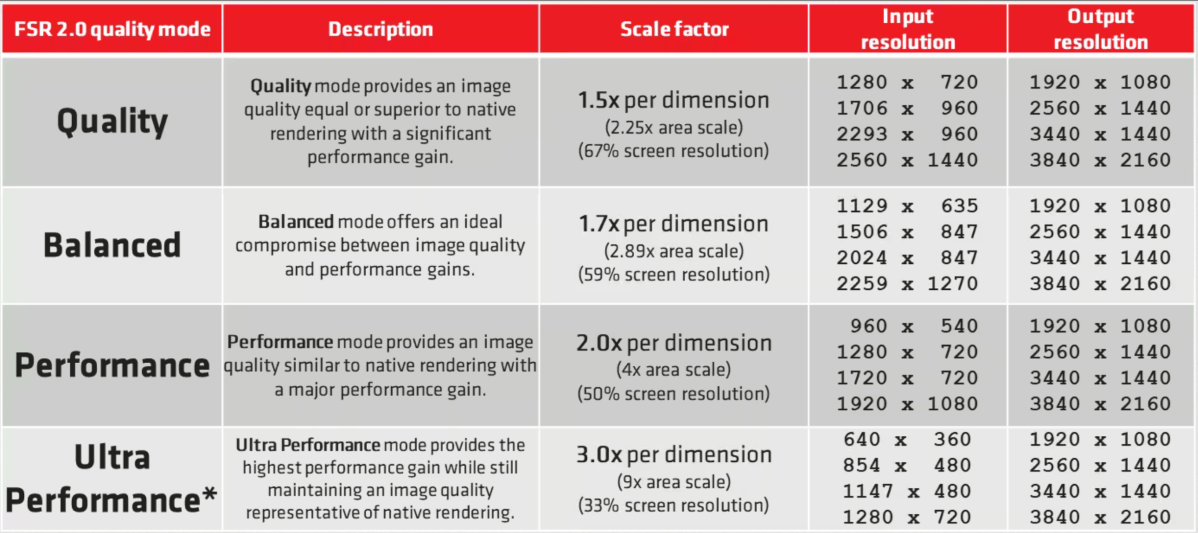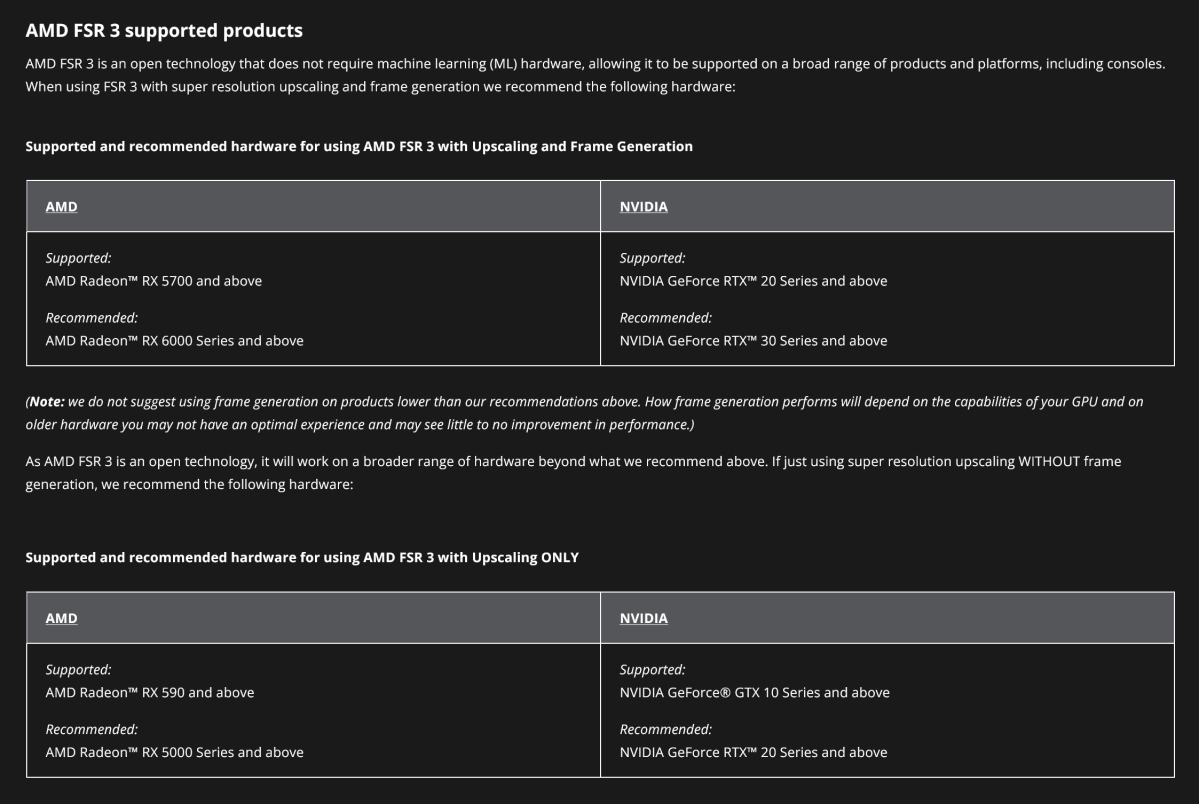AMD FSR 3 vs. Nvidia DLSS 3: Similarities and differences
 Image: Sven Bauduin
Image: Sven BauduinDue to their ability to get playable frame rates out of even relatively weak and old graphics cards, upscaling techniques such as AMD FidelityFX Super Resolution (“FSR”) and Nvidia Deep Learning Super Sampling (“DLSS”) are currently the talk of the town among gamers and developers alike. But where exactly are the similarities and differences?
We have taken a look at the topic of upscaling using the latest AMD FSR 3.x and Nvidia DLSS 3.x offshoots as examples and explain them in detail below.
The similarities
Both AMD FSR 3.x and Nvidia DLSS 3.x are still a “temporal” upscaling technology. AMD FSR 3.x goes back to AMD FSR 2.x, while Nvidia DLSS 3.x goes back to the first generation at its core. The first generation of AMD’s FSR, on the other hand, was still a so-called “spatial upscaling,” which had to manage entirely without a temporal component.
Nvidia DLSS 3.5 explainedAMD FSR 3 with Fluid Motion Frames explained
As temporal upscaling technologies, both AMD FSR 3.x and Nvidia DLSS 3.x use bilinear and neural upscaling techniques that allow the image to be “upscaled” from a lower resolution to a higher resolution, with the details as well as the textures being reconstructed with the help of algorithms.
When games are run at higher resolutions or with better image quality, the hardware requirements, especially for the graphics card, can often increase dramatically. AMD FSR 3.x and Nvidia DLSS 3.x provide a solution for running games at lower resolutions and then using upscaling techniques to increase the picture quality so that they look better on the screen and still run smoothly. This is all done in different presets, called “presets,” which are as follows:
Quality (1.5x upscaling): 1,280 × 720 pixels result in 1,920 × 1,080 pixels1.,706 × 960 pixels result in 2,560 × 1,440 pixels2.560 × 1,440 pixels result in 3,840 × 2,160 pixelsBalanced (1.7x upscaling):1,129 × 720 pixels result in 1,920 × 1,080 pixels1,506 × 847 pixels result in 2,560 × 1,440 pixels2,259 × 1,270 pixels result in 3,840 × 2,160 pixelsPerformance (2.0x upscaling):960 × 540 pixels result in 1,920 × 1,080 pixels1,280 × 720 pixels result in 2,560 × 1,440 pixels1,920 × 1,080 pixels result in 3,840 × 2,160 pixels
AMD has published an official table for this, which still refers to AMD FSR 2.x, but can also be used for AMD FSR 3.x and Nvidia DLSS 3.x. In practice, the presets Quality, Balanced, and Performance have prevailed, while Ultra Performance is generally no longer used in games.

AMD
AMD
AMD
Due to the temporal upscaling of both technologies, which enables the upscaler to also use the information of previous frames, only 50 to 67 percent of the later target resolution has to be calculated, depending on the preset. This significantly reduces the performance requirements for the graphics card.
Both technologies must be integrated into the respective game by the developer studios and do not function as a pure driver feature, which is why there are games that support both upscalers as well as titles that only offer AMD FSR 3.x or Nvidia DLSS 3.x.
Both AMD FSR 3.x and DLSS 3.x have a so-called interframe calculation, which can almost double the frame rate. AMD calls this feature Fluid Motion Frames (“FMF”), Nvidia calls it Frame Generation (“FG”). These functions are exclusively included in FSR 3.x and DLSS 3.x.
Both AMD FSR 3.x and Nvidia DLSS 3.x thus have the following feature set in common:
Temporal upscaling via super samplingInterframe calculation by means of frame interpolationQuality presets (“Presets”) with 1.5x to 2.0x resolution
In addition, both technologies offer a native anti-aliasing mode, which AMD calls Native Mode, while Nvidia has named it Deep Learning Anti Aliasing (“DLAA”). Both modes apply the algorithm of FSR 3.x or DLSS 3.x for edge smoothing to the native resolution, but do not upscale the image material at all.
The differences
As great as the similarities between AMD FSR 3.x and Nvidia DLSS 3.x may be, the differences are sometimes enormous: While AMD FSR 3.x is an open standard that supports virtually all graphics cards and thus also third-party products from Nvidia and Intel, Nvidia DLSS 3.x is a proprietary standard. Nvidia’s upscaling technology requires a graphics card from the company’s own GeForce RTX series from the last three generations.
Nvidia DLSS 3.x runs on the following graphics cards:
Nvidia GeForce RTX 2000 (“Turing”)Nvidia GeForce RTX 3000 (“Ampere”)Nvidia GeForce RTX 4000 (“Ada Lovelace”)
There are also restrictions with AMD FSR 3.x, but these only affect the intermediate image calculation using fluid motion frames and the native mode, as the manufacturer’s official FAQ reveals.

AMD
AMD
AMD
Unlike Nvidia DLSS 3.x, AMD FSR 3.x runs as a free standard on a large number of graphics cards. Several generations of AMD, Nvidia, and Intel are supported.
AMD FSR 3.x runs on the following graphics cards:
AMD Radeon RX 400 (“Polaris”)AMD Radeon RX 500 (“Polaris”)AMD Radeon RX 5000 (“Navi 10”)AMD Radeon RX 6000 (“Navi 20”)AMD Radeon RX 7000 (“Navi 30”)Nvidia GeForce GTX 1000 (“Pascal”)Nvidia GeForce RTX 2000 (“Turing”)Nvidia GeForce RTX 3000 (“Ampere”)Nvidia GeForce RTX 4000 (“Ada Lovelace”)Intel Arc A7, A5 and A3 (“Alchemist”)
Another major difference is the neural network, which has given Nvidia DLSS an AI component since the 1st generation and is also used for Nvidia DLSS 3.x.
While AMD FSR 3.x is still pure temporal upscaling, Nvidia DLSS 3.x is called temporal AI upscaling. The advantage that Nvidia DLSS 3.x takes from the raw data trained with the help of AI for the upscaling algorithm is not limited to the upscaler, but is used for many of the RTX features.
The training data calculated by thousands of supercomputers is processed by dedicated AI computing units called Tensor Cores as well as Optical Flow Accelerators, which should result in superior image quality.
Especially when ray tracing is activated, Nvidia DLSS 3.x with Ray Reconstruction can show its advantages.
With DLSS 3.5, a new feature moves into the AI toolset, called Ray Reconstruction, which improves ray tracing image quality by replacing the previously hand-optimized denoiser with an AI network trained by supercomputers.
With the help of Ray Reconstruction, pixels with a higher quality are supposed to be created automatically between sampled rays, which has a particularly positive effect on image quality and stability. Using Cyberpunkt 2077 as an example, Nvidia and CD Projekt Red have demonstrated how impressive this can look.
AMD FSR 3.x simply does not have such a feature and is thus at a disadvantage in terms of both performance and image quality when real-time ray tracing is activated.
Summary
The differences between AMD FSR 3.x and Nvidia DLSS 3.x can be summarized as follows:
Enterprises and platforms:AMD FSR is a technology from AMD and is primarily available for graphics cards from that manufacturer, but can also be used on certain third-party graphics cards.Nvidia DLSS is a technology from Nvidia and requires an Nvidia graphics card of the Turing or Ampere architecture.Functionality:FSR uses a combination of bilinear upscaling and machine learning to improve image quality. It reconstructs details and textures in a lower resolution image to scale them to a higher resolution.DLSS is mainly based on machine learning and artificial intelligence. It uses neural networks to convert low-resolution images to higher-resolution images, reconstructing details and textures.Availability:AMD FSR is designed to work on a wider range of hardware and in a wider range of games. Implementation is usually done by the game developers themselves.Nvidia DLSS requires special support from Nvidia, both on the hardware and software side. This means that game developers need to include specific support for DLSS in their games.Quality and performance:Image quality and performance impacts vary depending on the settings and versions of FSR and DLSS. In general, higher quality levels provide better image quality, but also require more GPU power.Nvidia DLSS has proven to be a leader in image quality and performance optimization in many cases. It can render games at a higher resolution on lower settings, while FSR tends to offer slightly lower image quality but is more widely available.Cross-platform support:While DLSS is limited to Nvidia graphics cards, FSR offers broader compatibility and can also be used on third-party hardware.
In the two videos below, AMD and Nvidia explain their current upscaling technologies once again in detail.
Gamers who do not yet know which graphics card is suitable for AMD FSR 3.x or DLSS 3.x will find corresponding recommendations in PCWorld’s graphics card comparison:
Best graphics cards for PC gaming 2023
This article was translated from German to English and originally appeared on pcwelt.de.
Author: Sven Bauduin, Autor

Sven Bauduin konzipiert und realisiert bereits seit rund 20 Jahren Computersysteme und berichtet über fast alle relevanten IT-Themen. Aktuelle Hardware wie Prozessoren, Mainboards, Arbeitsspeicher und Grafikkarten aber auch Betriebssysteme und Anwendungssoftware sowie Linux und Open Source sind seine Themenschwerpunkte.
Recent stories by Sven Bauduin:
6 basic mistakes to avoid when installing a motherboardDDR6 RAM: The next-gen memory standard, explainedHow long does computer RAM actually last?







